Bunny Hopped
- Share via
It’s 1967. Hippies hitchhike down the Sunset Strip. Sonny and Cher are still married and Gabe Kaplan pops off from time to time at the Playboy Club, where one of the valets is a young Peter Morton, later co-founder of the Hard Rock Cafe chain and now proprietor of Mortons. Occasionally, the bunnies stick their tails out the side door and taunt Morton by squealing, “Bottom’s up.” But one night at 7:30, something unusual takes place. The bunnies line up in front of the club, check their ears, collars and cuffs and wait. And then it happens. The Queen of England drives by in a long black limousine, and the bunnies, in their three-inch heels, wave as only bunnies can.
That night, 23-year-old bunny Pat Lacey had arrived at the club and passed the bunny inspection carried out by her bunny mother. Her nails were manicured, her hair was coiffed and her costume accentuated curves that made her one of the most desirous women in Los Angeles--one of the 125 bunnies who worked at the Sunset Strip Playboy Club.
A few years earlier, Lacey and her sister had taken a joy ride down the Strip. The pharmaceutical assistant from South Los Angeles gawked at the lights, at all the shiny cars filled with beautiful people. Something spectacular caught her eye. On the south side of Sunset, near Alta Loma Road, big bunny heads were majestically painted atop a fence surrounding a construction site. “From that point on,” Lacey says, “I wanted to be a part of Playboy.”
The next summer, Lacey put on a pink dress and went to a bunny hunt at the Playboy Club. When she didn’t get a call back, Lacey called Hugh Hefner’s office and told his secretary that that she had been out of town. Asked to describe herself, Lacey said that she was African American and that she had worn a pink dress. “Oh, we had been trying to find you but we didn’t know who you were,” Lacey says the woman responded. And Lacey became one of seven chosen out of 300 other wannabe bunnies.
“Playboy offered entree into a world for a young black woman,” she says, “that I could not imagine.” The pay was terrific--Lacey averaged more that $500 a week in tips--and the perks were generous. Bunnies were allowed free into all the clubs along the Strip, and the company offered to pay 80% of the bunnies’ college tuition. And when she put on that costume, well, she felt magnificent: “It did wonders for my figure that my figure couldn’t do on it’s own. It pushed you in and it sucked you up. And the fact that you were surrounded by beautiful women, you became even more beautiful.”
Once selected, Lacey had to take a rigorous six-week course to learn such positions as the bunny dip (back to the table, with knees bent), bunny crouch (deep knee bend, in heels, with tray on knees), all of which had to be done while serving chicken Kiev or filet mignon or scotch on the rocks. There were also the bunny stance (weight on one leg, tray at waist level) and the bunny perch (sit high with both feet on the floor). When men proposed to their girlfriends in that club, the bunnies giddily hid the ring in a cocktail, a salad or a dessert. Others brought a different woman almost every night, only to be met with a knowing glance from the bunny who had served him the other evening.
The bunnies were phased out in 1986, but Lacey still works at Playboy as a promotions assistant. It was the heyday of the Strip club in the late ‘60s and early ‘70s that made Lacey feel part of something bigger. While U.S. sprinters Tommie Smith and John Carlos were causing a ruckus at the 1968 Olympics, when they raised their black-gloved fists in a power salute on the medal stand, Lacey and three other African American bunnies came into the club one evening wearing their first afros. “I thought my bunny mother was going to die when I walked in with that afro,” Lacey recalls. “In those days, an afro was Angela Davis. It was militant.” Three weeks went by and the afros just became another part of the bunny landscape. “I wish,” she says, “we could have those days back again. . . . The club had its place and its time.”
More to Read
Sign up for The Wild
We’ll help you find the best places to hike, bike and run, as well as the perfect silent spots for meditation and yoga.
You may occasionally receive promotional content from the Los Angeles Times.






